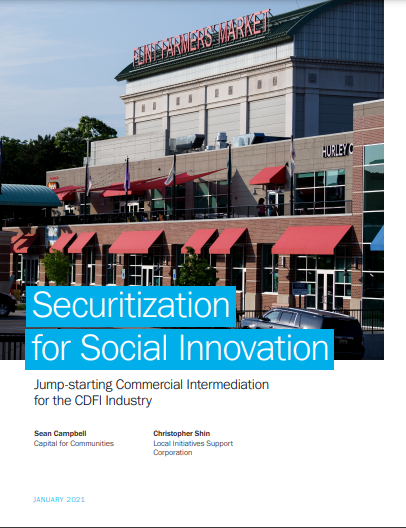Securitization for Social Innovation
Could CDFIs increase their liquidity and expand their reach through securitization? A new LISC white paper looks at the opportunities, challenges and next steps needed to launch commercial intermediation and create a secondary market for CDFI assets—so that more high-impact capital can flow to communities.
Executive Summary
This white paper advocates for the creation of an intermediary business between community development financial institutions (CDFIs) and capital markets. This business would structure financial products backed by assets acquired from CDFIs, thus mobilizing more mainstream capital for CDFIs of all sizes and enhancing their community lending capacities in a sustainable manner.
The proposed intermediary would assist CDFI loan funds in particular and the local communities they serve in gaining access to capital through a new and currently unavailable channel for the CDFI industry: asset-backed securities. Many CDFIs face the ongoing challenge of diversifying away from traditional CDFI funding sources and tapping mainstream capital markets using, for example, bond issuances. An intermediary can lower barriers to such funding by acquiring the assets of CDFIs regardless of their sophistication or size and packaging, or securitizing, those assets in a manner suitable to different types of investors. This approach enhances CDFIs’ investing capacity more than directly lending to CDFIs, since CDFIs can originate a loan, sell it off to the intermediary, and use that recovered capital to make more loans without encumbering their balance sheets with additional debt. Moreover, the intermediary allows public and philanthropic actors to support CDFIs quickly and effectively, which has become an even more pressing need in this pandemic-stricken environment. Governments and foundations can provide funds or guarantees to support a structure that acquires significant volumes of assets from a multitude of CDFIs without those public entities having to seek out and engage directly with each individual CDFI. An intermediary business should specialize in acquiring CDFI assets and actualize the advantages of such an approach for the CDFI industry, with the guiding motive being acceleration of funding for economic development and equity in the United States.
In fact, the New York Forward Loan Fund (NYFLF) is a successful example of CDFI intermediation and asset acquisition. The NYFLF has enabled numerous private and state actors to commit tremendous funds for investing in thousands of small businesses and nonprofits across New York State through the mission-oriented work of CDFIs, a targeted scale of investment that would not have occurred but for intermediation. The NYFLF aggregated over $100 million of private capital and government guarantees to purchase small-balance loans originated by five New York-based CDFIs. The loan fund trust (the intermediary) repays its investors in a tranched structure, while allowing the CDFIs to service the acquired loans to mitigate defaults and ensure better financial and social outcomes. The key to successful intermediation of this nature is fund administration, which in the case of NYFLF is performed by Local Initiatives Support Corporation (LISC). LISC has provided the critical investor and originator services, legal and operational expertise, and IT systems that ensure smooth transfers of information and payments between all parties. NYFLF demonstrates that financially viable CDFI asset acquisition is already being implemented; the intermediary proposed herein would take this initial proof-of-concept one step further: building capital structures backed by CDFI assets and issuing them in the global capital markets, a business model this white paper coins as “commercial intermediation”.
Finally, this white paper sets forth in detail the necessary functions and capabilities of a self-sustaining intermediary to CDFIs, as well as the challenges to achieving commercial intermediation. Similar to the duties of LISC for NYFLF, the intermediary would work with investors and guarantors with various risk-return goals, source loans and investments from CDFIs to create the asset-backed structures, and manage those structures on an ongoing basis. Utilizing analyses of CDFI asset characteristics and quality, this white paper argues that a commercial intermediary could securitize CDFI assets, i.e. pool such assets and sell securities backed by structured claims against the pools, and that the securitization of CDFI assets can simultaneously accommodate the social mission of CDFIs while competing in the marketplace for the investments of institutional investors. In addition, this white paper describes the advantages and limitations of applying two types of collateralized structures to CDFI intermediation: commercial mortgaged-backed securities and flexible asset-backed securities. Overall, this white paper seeks to outline a clear blueprint for a CDFI commercial intermediary; only the commitment and execution of a capable team is needed to take this blueprint and build the next groundbreaking institution in financing community development.
